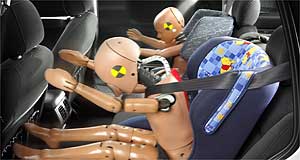Child-seat safety reform urged
BY BYRON MATHIOUDAKIS | 7th Dec 2004

Led by the Monash University Accident Research Centre (MUARC) in association with Holden, the research involved front and side-impact testing of dummies in child restraints, booster seats and seatbelts alone. It found seatbelts designed to save adults could cause serious abdominal trauma to children aged up to 10 years old because a child’s pelvic bone region, which the belt physically restrains in adults, is not fully developed and allows for harmful intrusion.
Furthermore, a debilitating neck injury could occur since an ill-fitting sash belt also cuts into that region simultaneously.
“Evidence shows that the five to 10-year-olds have a higher crash risk and, disturbingly, only about 12 per cent of this group are in boosters,” said MUARC senior research fellow Dr Judith Charlton.
Dr Charlton said children taller than 100cm and weighing more than 18kg should be correctly secured in belt-positioning booster seats until adult lap and shoulder belts fit them properly.
“(This is at) usually between eight and 10 years old approximately,” she said.
The adoption of child restraints with European ISOfix fixed lower anchorage points – currently prohibited under Australian Design Rules – is also recommended.
ISOfix is being reviewed under child safety seat legislation reform by Standards Australia that is due next year, along with the US-preferred adjustable belt strap around the base and vehicle anchorage point set-up known as LATCH system.
MUARC said that both outperformed the current seatbelt strap set-up.
In addition, the rigid ISOfix greatly reduces the other types’ potentially harmful pitching and lateral movements, which can allow a child to strike other objects in an impact.
MUARC recommends:
- Booster seats should be high-sided and head supporting, to stymie irreversible brain damage due to head strikes.
- Buyers should demand seatbelt guides to avert neck and abdomen harm and a crutch strap to prevent a child sliding forward and under, averting internal, neck and leg injuries.
- All children should be secured in the back seat.
- A child in a vehicle with side airbags should be placed in the centre.
- Avoid using second-hand equipment as its effectiveness can be compromised with age or multiple use.